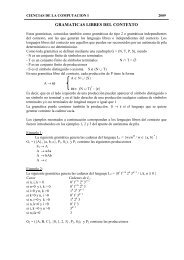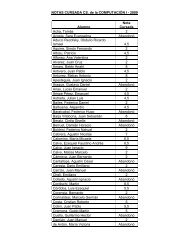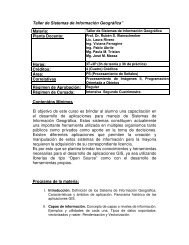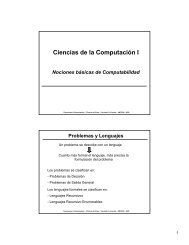Libro de Resúmenes / Book of Abstracts (Español/English)
Libro de Resúmenes / Book of Abstracts (Español/English)
Libro de Resúmenes / Book of Abstracts (Español/English)
Create successful ePaper yourself
Turn your PDF publications into a flip-book with our unique Google optimized e-Paper software.
Resumenes 167<br />
obteniéndose que siempre existe una curva seperatriz que divi<strong>de</strong> el<br />
comportamiento <strong>de</strong> las trayectorias <strong>de</strong> modo que si la relación presa<strong>de</strong>predador<br />
es pequeña implica la extinción <strong>de</strong> ambas poblaciones.<br />
En este trabajo se utiliza la alternativa propuesta en [STE 99, WANG<br />
99] modificando la función <strong>de</strong> crecimiento logística mediante la agregación<br />
<strong>de</strong> un término <strong>de</strong> mortalidad adicional representando el efecto Allee, el cual<br />
nx<br />
ahora es <strong>de</strong>scrito por la función A(<br />
x)<br />
= , la cual crece asintóticamente<br />
x + b<br />
con la <strong>de</strong>nsidad <strong>de</strong> las presas. En el libro <strong>de</strong> Thieme [THI 03] se hace una<br />
<strong>de</strong>ducción matemática <strong>de</strong> esta forma que llamaremos efecto Allee aditivo.<br />
La interacción queda expresada por el siguiente sistema <strong>de</strong> ecuaciones<br />
diferenciales <strong>de</strong>l tipo Kolmogorov [FREED 1980]:<br />
dx ⎛ x n ⎞ qxy<br />
= rx⎜1−<br />
− ⎟−<br />
dt ⎝ K x + b ⎠ x + a<br />
dy ⎛ px ⎞<br />
= ⎜ −c⎟y<br />
dt ⎝ x + a ⎠<br />
don<strong>de</strong> x = x(t) y y = y(t) son los tamaños poblacionales <strong>de</strong> las presas y los<br />
<strong>de</strong>predadores, respectivamente, para t > 0 y los parámetros tienen<br />
diferentes significados biológicos.<br />
Se pue<strong>de</strong> <strong>de</strong>mostrar que ambas formas <strong>de</strong>l efecto Allee son<br />
topológicamente equivalentes, pero estudiaremos si las consecuencias <strong>de</strong><br />
la forma aditiva son similares a las <strong>de</strong> la forma multiplicativa. Se hace<br />
entonces un análisis cualitativo <strong>de</strong>l mo<strong>de</strong>lo obtenido mediante la teoría <strong>de</strong><br />
los sistemas dinámicos y obtenemos condiciones en los parámetros para<br />
establecer el diagrama <strong>de</strong> bifurcaciones <strong>de</strong>terminando:la cantidad <strong>de</strong> los<br />
puntos <strong>de</strong> equilibrio en el primer cuadrante, la naturaleza <strong>de</strong> cada uno <strong>de</strong><br />
ellos, la existencia <strong>de</strong> curvas separatrices, curvas homoclínicas o<br />
heteroclínicas, la cantidad <strong>de</strong> ciclos límites, etc.<br />
Dynamics <strong>of</strong> Rosenzweig-McArthur predation mo<strong>de</strong>l<br />
consi<strong>de</strong>ring an additive form for the Allee effect<br />
The dynamics <strong>of</strong> a population is its <strong>de</strong>velopment in space and time; it<br />
is <strong>de</strong>termined by factors that act in the organism, in the population and in<br />
the environment. The population size <strong>de</strong>pend on their natality, mortality,<br />
migration and some <strong>de</strong>pend besi<strong>de</strong>s the initial <strong>de</strong>nsity to be able to grow<br />
and to remain in the time.<br />
In this work we analyze a Gause type predator-prey mo<strong>de</strong>l [FREED<br />
1980], assuming that the natural prey growth it is affected by the Allee<br />
effect. In Population Dynamics, any ecological mechanism that can establish<br />
a positive relationship between measurable component <strong>of</strong> individual<br />
fitness) and either the number or <strong>de</strong>nsity <strong>of</strong> conspecifics can be called<br />
mechanism <strong>of</strong> Allee effect [KEN 03, STE 99] or <strong>de</strong>pensation [CLARK 90,<br />
DENN 89, LIER 01], or negative competition effect [WANG 99].<br />
The Allee effect is an important and interesting phenomenon in both<br />
biological and mathematical sense. From biological point <strong>of</strong> view, the Allee<br />
effect it produces to low population <strong>de</strong>nsities when the individual growth<br />
rate is a increasing function with <strong>de</strong>nsity [DENN 89], and for this its<br />
possibilities <strong>of</strong> extinction increases [COURC 99]; the importance <strong>of</strong> this



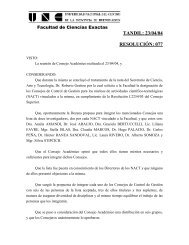
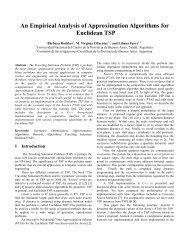
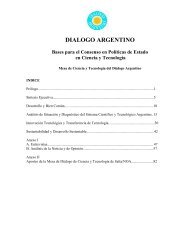


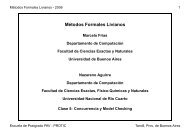
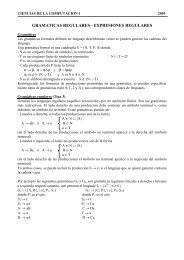

![Clase 13 [pdf]](https://img.yumpu.com/19616969/1/190x245/clase-13-pdf.jpg?quality=85)

